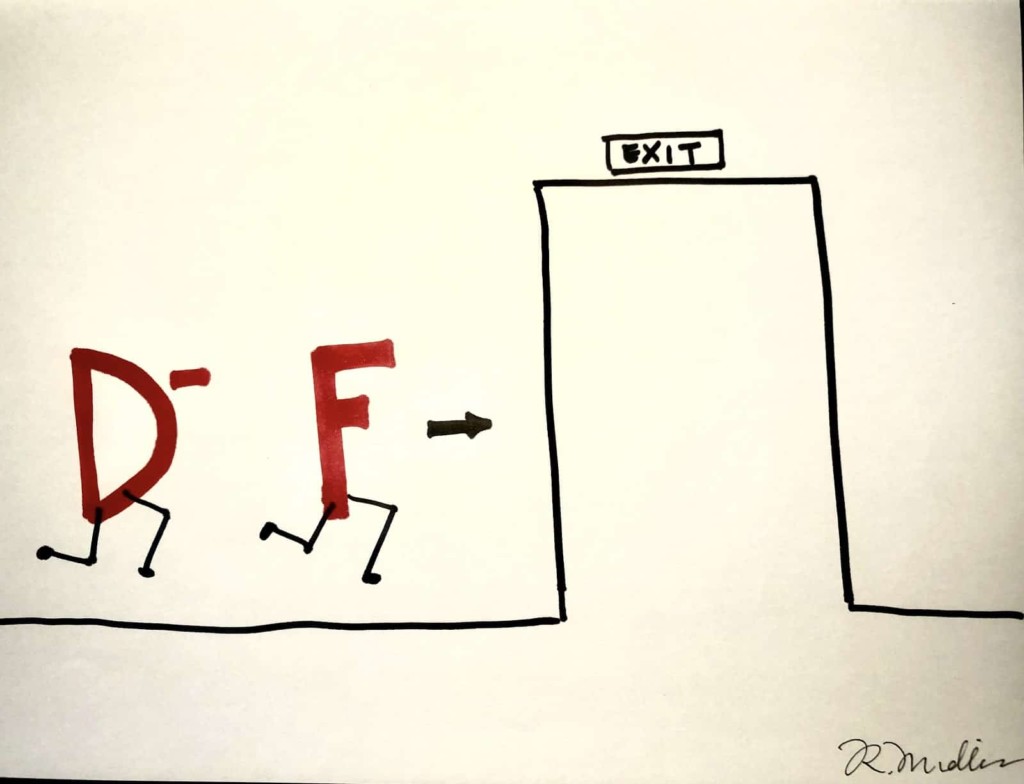Get the F Out

Many American schools just issued midterm grades and there were a lot of Ds and Fs. The record number of failing grades is a report on schools as much as students. The shift to remote and hybrid (part-time at school, part-time online) learning has failed to engage millions of learners in a meaningful way.
For most remote and hybrid students, the learning experience is not good, it’s a bolted together digital version of school that lacks relevance particularly for high school students. Schoolwork that was boring in February got even worse online without the in-person motivation of a great teacher. Millions of students have checked out and face serious long term consequences.
Most teachers are just trying to do what their districts told them to do and drawing from what has worked in the past. They are grading assignments and handing out pop quizzes used to encourage attendance and homework diligence.
Let’s admit that grades are a mess. For most, they are an idiosyncratic time-series average of performance feedback, rewarded effort, and attendance incentives. Grades sort of worked pre-Covid (at least better than standardized tests) as a means of charting progress but now nothing is working very well.
It’s worth acknowledging that (like climate change, an inequitable economy and the pandemic) the epidemic of failing grades is disproportionately hitting learners from low-income families of color. They are the ones most likely to be learning online and doing so in poor conditions with limited privacy and spotting wi-fi–no pods, trips or tutors for the group that could most use them.
There are two solutions to the near term problem of widespread failure: expand supports and get creative about completion.
Back-on-Track Supports
The first solution is to try to find learners that haven’t engaged or enrolled. Some school districts are going house to house to locate disengaged students. Developing a relationship, identifying options, and initiating engagement can help get learners back on track.
For failing students, root cause analysis can help. Failure to engage could be due to a lack of study space, problems with wi-fi, family work requirements, or health issues. A systematic approach to identify needs, reducing barriers, and reengagement can get learners back on track. As the Tiered Support resources from Turnaround for Children illustrate, community partners can play an important role in providing youth and family services.
To fill learning gaps or replace missed units and failed quizzes, teachers can use alternative assessments to allow students to demonstrate mastery. Academic modifications can also help–that might include a modified load, setting, or schedule with additional small group support.
Get Creative About Completion
The other solution is to ditch the prescribed path and co-construct an alternative with a struggling learner. Help learners create authentic purposeful experiences. Build a community connected project or entrepreneurial experience that counts for one or two failed courses.
A learner concerned about racial injustice could develop an art exhibit and write about the economics of oppression. Art and Science mashups and English and Social Studies integrations are common in High Tech High and New Tech Network schools. Project 901 at Crosstown High that combines a place-based research project for English and AP History credit.
Look for ways to count work or service experience for high school credit. Help a learner conduct a market test for a new business concept for a business math and English credit.
Teachers and learners could also identify learning pathways like NROC and Khan Academy for math. Evidence from those resources could be used in full or in part to demonstrate mastery.
Get creative, you can help young people construct valuable experiences and find ways to get them credit. Your school board and state board will probably give you more flexibility than you imagine.
Eliminate Failure With a Shift to Competency
The longer-term solution is a competency-based system where failure is not an option–it just means “not yet.” Competency systems make learning targets clear, they empower individual progress based on demonstrated mastery, and they provide time and support for all learners to succeed.
The Aurora Institute identified seven design principles for competency-based education:
- Students are empowered daily to make important decisions about their learning experiences, how they will create and apply knowledge, and how they will demonstrate their learning.
- Assessment is a meaningful, positive, and empowering learning experience for students that yields timely, relevant, and actionable evidence.
- Students receive timely, differentiated support based on their individual learning needs.
- Students progress based on evidence of mastery, not seat time.
- Students learn actively using different pathways and varied pacing.
- Strategies to ensure equity for all students are embedded in the culture, structure, and pedagogy of schools and education systems.
- Rigorous, common expectations for learning (knowledge, skills, and dispositions) are explicit, transparent, measurable, and transferable.
These principles have big implications–it’s a multi-year change process to incorporate all of them even in high capacity systems. A good place to start–especially in this crisis where we are seeing record levels of failure–is to eliminate grades of D and F and move to a policy, practice, and culture of “not yet.”
For more see:
- Getting Smart on Mastery Learning
- Show What You Know: A Landscape Analysis of Competency-Based Education
Stay in-the-know with innovations in learning by signing up for the weekly Smart Update. This post includes mentions of a Getting Smart partner. For a full list of partners, affiliate organizations and all other disclosures, please see our Partner page.

Tom Vander Ark







DR. KENNETH W JONES
Tom/Rebecca,
Good article. Where do you begin with a competency-based model and what do you do about the high school seniors who are supposed to graduate this spring?
I believe there is an important place for higher education when trying to figure out the best way to support today's high school seniors. Higher Ed could help identify what they would accept as proof of competency. This work must begin right now, if school districts are to save their high school seniors.
Replies
Dr. Jones,
Thanks for the feedback! We think what you're saying about Higher Ed is right on. If you're interested in more competency-based conversations (led by the author, Rebecca), check out our new page: https://gettingsmart.com/cbe
Thanks again!
Daniel Weaver
Competency based systems have their merits, but the practical outworking are difficult under the current public school paradigm. To abolish grades ultimately means abolishing grade levels. Both grading and grade-levels are things I would love to see changed. It does raise the question, "What other things would have to change?